Transcript of "Lost Decades: The Making of America's Debt Crisis and the Long Recovery"
October 14, 2011
Friday, October 14, 2011
Moderator:
GEORGE AKERLOF, International Monetary Fund
Panelists:
MENZIE CHINN, University of Wisconsin, Madison, Econbrowser
JEFFRY FRIEDEN, Harvard University
GAIL COHEN, Joint Economic Committee of the U.S. Congress
DIANE LIM ROGERS, Concord Coalition
SIMON JOHNSON, Massachusetts Institute of Technology, Peterson Institute
| Video of the event |
MR. AKERLOF: Welcome. So I should begin by saying that I’m tremendously honored to be the moderator of this session; that Menzie and Jeff have written a terrific book about the causes and also the implications of the financial crisis. Now, I want them to speak for themselves but maybe I can take just a few minutes to say a few words of introduction.
The topic of the book is how the large scale imbalances and especially the external balances that worry us so much here at the IMF have played a major role in our current crisis.
So, the title of the book is highly leading. One has to read the title twice just to check that yes, there is an S at the end of decade, so it’s Lost Decades. Okay. So they’re projecting that we’re going to be in this problem for a long time.
The book clearly sets out how we got into the crisis. Now, there are many good reportorial books on the crisis. They’re very good. I enjoy them a lot but the typical book does the following: it focuses on how what happened at my bank, be it Lehman Brothers or J.P. Morgan or Goldman Sachs, etcetera, that caused the crisis. They seem to forget about all the other banks that some other report has written about. They, in some sense, have the shooting of the Archduke Ferdinand caused World War I. That’s their -- in contrast, when you look at Lost Decades, it steps back and it takes the broad view of what caused the crisis. So it tells us what really happened and it gets the economics and it gets the politics. It gets it right.
So let me just say few more words because I want them to do the speaking plus the discussion. I’ve known Menzie a lot longer than I’ve known Jeff so let me mainly talk about Menzie. Menzie was even my TA in Graduate Macro at Berkeley. And when he left Berkeley I remember writing a job market letter for him. And there was really a remarkable thing on his CV. In addition to the usual Ph.D. style papers that everyone writes, he had an expository paper; an expository paper that explained in clear English for graduate students and for advanced undergraduates and for economists generally the subject of co-integration and Dickey-Fuller tests.
Now, it was very well done but more than that it was really, truly remarkable. It was remarkable for a graduate student to take on the big picture in such a way. I’ve actually never seen any other graduate student, either before or since, who has ever come close to doing such a thing. Now, I have a friend who once sat next to the wife of Sir Edmund Hillary. And the wife, in explaining some amazing Sir Edmund exploits, she remarked, “Well, he does things like that.” So that takes me back to Menzie. He does things like that.
And that in turn takes me back to Lost Decades, which is the joint product of Jeff and Menzie. It’s an extraordinary and unusual accomplishment. So now I’ll let Menzie and Jeff give you their own perspective on Lost Decades. Thanks a lot.
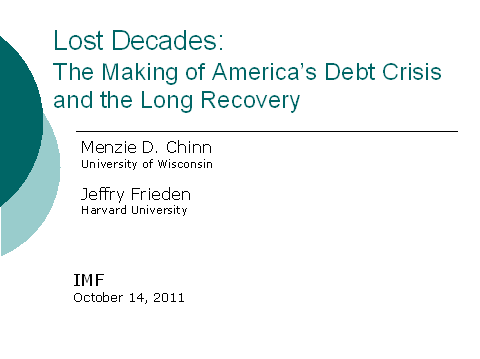
MR. CHINN: Okay. Well, thank you so much to George for those very warm words and a walk down memory lane. I’d forgotten about the paper almost. But I’m hopeful that we’ve lived up to applying our learning to an important issue. Thanks also to Prakash Loungani and IMF for allowing us to have this opportunity to speak to you about this book.
And let me just preface this before I jump into the material. I’m going to be very abbreviated, but let me just mention that we wondered whether the world was ready for yet another treatment of the financial crisis. You know, we knew that it would take a long time to write. It actually did take longer than we even anticipated. And we were afraid that all the things that needed to be said would have been said by the time the book came out and that people would have tired of the crisis. But I think as we go through this I hope you will agree that many of the predictions we made are -- seem to be coming to pass. And in addition, the challenges that we outlined are indeed the challenges that we’re facing in Europe, and we’re just starting now to deal with the issues in terms of adjusting to the next decade, which is what Jeff is going to be talking about.
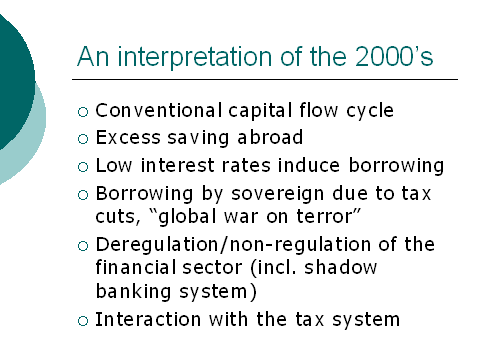
I’m going to talk mostly about the interpretation of the crisis and hopefully that will spur some interest in terms of thinking about how that differs from other interpretations. So our interpretation is that, in fact, it’ll be familiar to people in this institution, that in some ways we’ve seen a conventional capital flow cycle. That is we’re tuned as Americans to thinking about the events of 2008 as being something quite special. And in some respects it is special, but in some respects we’ve seen this sort of event happen over and over again in the past. And so what we saw leading up to 2008 was the combination of excess savings abroad inducing in some part low interest rates here, but not fully. That led to borrowing, excessive borrowing, borrowing on the part of the government. So we have the sovereign, the U.S. government, borrowing tremendous amounts starting in, you know, 2001 onwards, partly due to tax cuts, partly due to recession, partly due to these expenditures that we hadn’t anticipated beforehand, the global war on terror.
But I think in contrast to some other treatments where America is just borrowing and we have all these savings abroad that are being forced upon us, that is we just can’t say no to the availability of cheap credit, we also think that domestic factors are critically important, including the deregulation or the non-regulation of vast waves of the financial sector. And that includes the now famous shadow banking system which, just speaking as myself, you know, 10 years ago, five years ago, as a macroeconomist I didn’t really pay attention to. You know, we just said the financial system is just this plumbing and it just seems to plug along just fine. I think that was a big mistake and we’re all paying that price as policymakers and academics thinking about the workings of the economic system.
And on top of that there’s a whole interlay of interaction with the tax system, which we haven’t dealt. We have these incentives built in on top of the fact that we didn’t regulate the financial system that induces households, corporations to borrow excessively both in the non-financial and the financial sector. And actually, if I can turn to my teacher, a lot of the ideas that we have here, I think, resonate strongly with Professor Akerlof’s paper with Paul Romer about how distortions in one part of the economy, particularly incentives to extract or loot, can distort a whole financial and economic system. And so that’s a subtext that you might not detect going throughout the book but it’s definitely there.
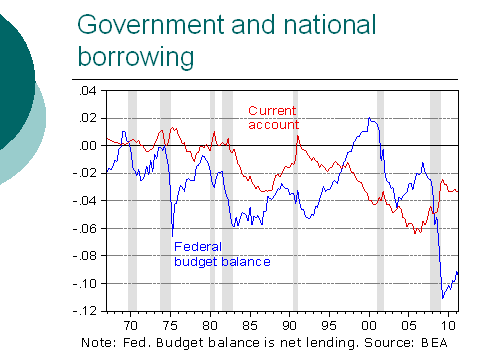
So now let me just throw up a couple of pictures to highlight the fact that it’s not always that public saving has been driving the current account deficits. You know, we know this idea of the twin deficits which was popular in the ‘80s. It was dispelled largely in the ‘90s. And then I think if you look into the 2000s, it’s kind of hard to see but with a lag of a couple years the big fiscal expansion leads in part to a worsening of the current account. And so we believe that part of the story is definitely fiscal profligacy. It’s not the only part but it’s a part. And as I go forward we’re not going to say that the total effect is just the sum of each of these components; that there’s a synergistic effect going forward.
So we have this correlation here that we think is important, and it’s not true in all financial crises of this nature but it seems to be true in this 2008 episode. Now, along the way there’s a discussion of the fact that, well, you know, was the current account deficit our doing or was it because there’s all this saving from the rest of the world expecting to flow into America? Or alternatively, was it that the Fed was driving down interest rates?

Well, we think it’s combinations of both. I’ll just mention that, indeed, if you look at this time series plot of the real interest rate at the 10-year horizon measured in a variety of ways, you’ll see that it drops. And I should put in the zero line. It’s pretty low historically speaking in about 2003-2004. And if you looked at short-term interest rates, those would be also rock bottom low. So it’s definitely true that real interest rates were low and that spurred some of this asset bubble-like phenomenon.
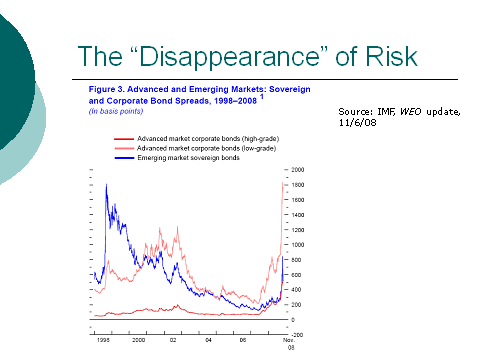
One thing that we do want to stress though is I don’t think that you can just gather all this from the risk-free rate. This is taken from the World Economic Outlook a few years ago. The one thing I’d like to point out is that not only were interest rates low but spreads on risky assets were also low. And so look at, for instance, advanced market corporate bond rates, the low grade, that’s kind of a measure of the spreads. Those things were remarkably low in the ’03-’04 period as well. And just to link up with current events, you can think of the similar disappearance of “risk” in Europe, let’s say Greek bonds versus German bonds. You know, people were mystified. Where did the risk go? Our assertion was it was hidden. It was hidden either by implicit guarantees or by virtue of financial innovation that allowed an inordinate amount of certainty or belief that you had insured yourself against risk.
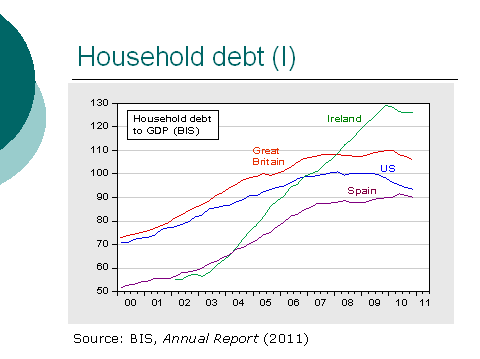
What’s that all do? It leads people, households, to rationally build up debt. And these are just pictures of debt according to the BIS. Household debt to GDP. Okay? And a critical thing to take from this picture is it’s going up for a whole bunch of countries. These countries you might notice have a commonality of being countries in trouble right now. So the U.S. rises, but actually we’re not the worst offender. Ireland also moves up quite rapidly.
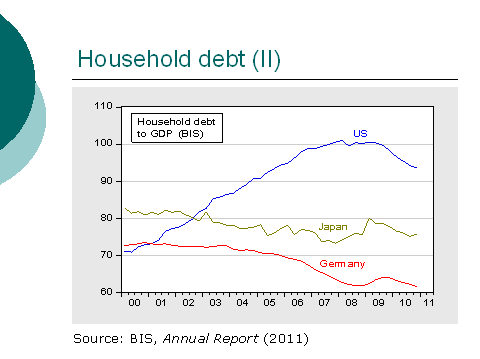
Now, it’s not true that everybody is experiencing an increase in debt. Japan is a case where it already had gone through it’s sort of bubble economy but, you know, you could find other examples. Germany is an instance where you didn’t see the equivalent rise in household debt. So you might have said everybody in the world was increasing its leverage. That’s not true. There were some countries that did not. And Germany and Japan are two instances.
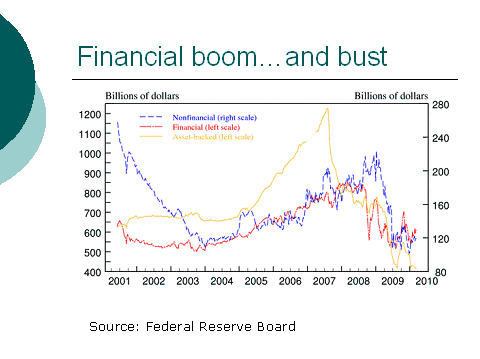
What did that leave? It’s hard to say what causes what. But let us just say that here’s a picture that illustrates what was going on in the background. So we think about debt but what about the financial plumbing that was going on behind? And these are pictures of the volume of corporate paper, which is essentially short-term borrowing. And the one thing I wanted to bring your attention to is while there are these lines that are going up throughout the 2000s -- the blue line, the red line -- the one thing that’s shooting way up is the orange line. And you look at that and what is that? If you can’t quite read it, it’s asset-backed corporate paper. And what is that? That in turn is -- a lot of the stuff that you heard about: mortgage-backed securities and CDOs, the slicing and dicing. What was the debt that was being sold? That’s essentially this orange line. And through ’05-’08, a big chunk of that, large chunk, was the housing mortgages or the mortgage debt that was securitized. That’s what that boom is.
And what you see is you might have looked at other indicators in the economy and said this is not too big of a departure from the past. But what we see here is a tremendous jump up in this particular aspect and a particularly unregulated component of the financial system until a collapse in 2007. And that’s the slow motion aspect of the crisis. If you had not been paying attention you would have said, wow, everything burst out in 2008. But it was actually something that was unfolding over time.
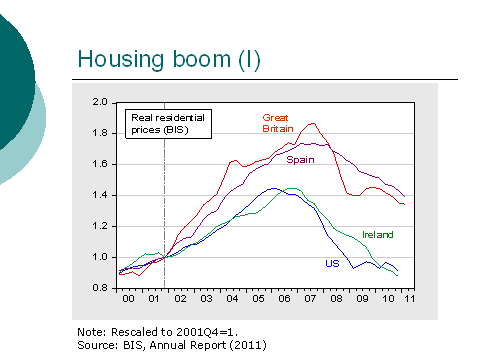
Well, what’s the real world manifestation of this? And I’ll just talk a little bit about the most obvious aspects. The one is just in housing. So you have residential prices booming, obviously. Once again, the U.S. is not the only instance. It’s actually not the worst instance, but if you think about the U.K., it’s another instance where securitization and financial innovation has progressed incredibly far. It’s also another country that had a big current account deficit. And so in some ways you could say that they’re actually a more extreme manifestation of what occurred here and they’re also in the worst shape because financial services are a larger component of their economy.
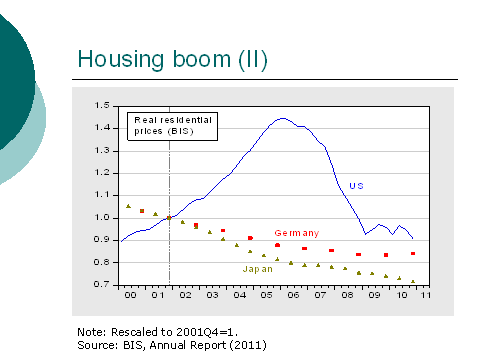
It’s not true that all countries suffer the same fate. You hear a lot about the fact that the housing boom was global. It’s not. So you look at Germany. Even if you take Japan out, Germany is a counter example. It’s an instance where you didn’t experience that boom.
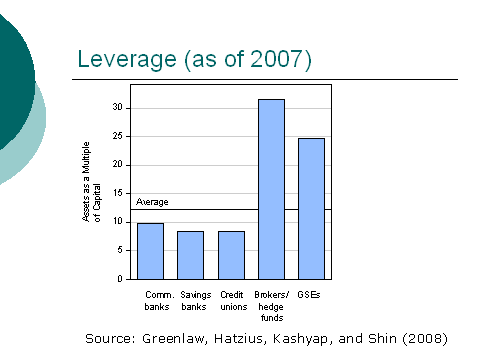
One of the last two pictures I want to show you is, where did all this come from? Where did all the funds come from to finance these booms? And so once again coming to how our treatment differs from other treatments, I’d like to say we do believe that financing from abroad was critical. Okay. You ran big current account deficits. That’s capital inflows from the rest of the world. Those flows were readily accessible by virtue of either foreign central banks willing to purchase U.S. Treasury bills and bonds and so forth. But, it’s not completely a foreign story. It’s also a story in the U.S., where we allow our institutions to leverage up. And what is this? This is the ratio of the assets, the things that the financial institutions own relative to how much of their own money they put in. You know, in common parlance now, what’s the skin in the game? Thank you. The sports metaphors elude me. So skin in the game that they have themselves, the owners of these firms. And you notice that the parts that were regulated tightly were pretty low. Okay. They’re below this average.
But what was highly leveraged were the government sponsored enterprises -- Fannie Mae, Freddie Mac -- but they were regulated along other dimensions.
But in particular you look at this really high bar that exceeds 30 -- that means that the assets they have, they’re over 30 times what they’ve got their own money in these ventures, backing it up, you know, where did they get the rest? They borrowed it. That’s this issue of leverage. Who are these people? Well, they’re the hedge funds and when you see brokers you think the investment banks. And you think where did the crisis break out in full bloom most profoundly to begin with? It’s these highly leveraged institutions. But, they were both too big and too interconnected to sort of cordon off or to being off from the rest of the economy. So for us, I think a big issue is that -- not just that you had flows of capital coming into the U.S. That’s partly endogenous. It’s partly indigenous responding to the fact that we had allowed this incredible leveraging up in a key part of the financial system that was lightly regulated.
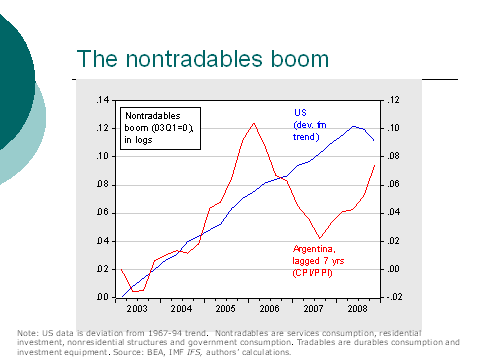
The last thing is to bring in some international finance. And so those of you who are students of financial crises in emerging markets will know that there’s a stylized fact that you see these non-tradables prices boom as capital flows in and then, in the words of Blustein, the money kept rolling in until it stopped and then it rolled out very quickly. What you typically see is booming non-tradables prices and then a bust.
And so what I’ve got here is a picture of Argentina, like seven years, and what you see there is a quite sharp jump up in non-tradables prices and then a collapse as you go into the crisis. And in the U.S., we don’t have quite the same sharp pattern. You have to work at it a little bit but what’s true is that there’s this increase in the trend growth rate of non-tradable prices in the U.S. and then, as you hit the crisis, that bust is just starting now. We’re just seeing an adjustment back away from non-tradables, like housing for instance and services, and towards a situation where hopefully the U.S. economy is going to be moving toward something that’s more sustainable. That sustainable part, the political aspects of that adjustment process I’m going to turn over to Jeff.
MR. FRIEDEN: Right. So we turn to political economy and I think we’ll see that political economy is the truly dismal science as we think about the implications of the crisis.
So Menzie has developed the idea -- which we develop in the book -- that we can think about this as a classic debt crisis in which a country realizes a very substantial capital inflow and that leads to all the effects that we associate with major capital inflows in other countries around the world, whether other countries in this cycle, such as Spain or Ireland or Portugal or Greece, or other countries in history, such as Brazil or Turkey or Russia or the U.S. in the 1880s and 1890s or Germany in the 1920s, drawing the connections between the economic effects or the economic characteristics of the capital inflow and now turning to the aftermath of the crisis, the political economy of what a crisis leads to.
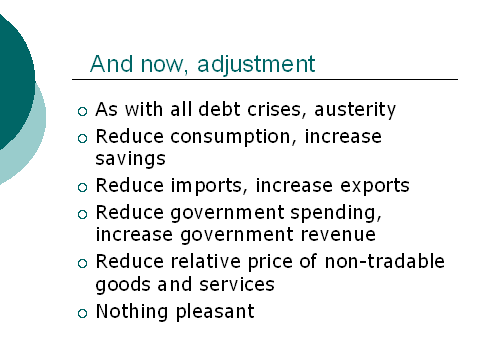
And the backdrop to this is very simple, which is that a country faced with a debt crisis effectively is driven sooner or later towards austerity measures. In the case of the U.S., as in the case of other instances, we borrowed from the rest of the world and that allows us to consume more than we produced. It allowed us to invest more than we saved, and it allowed the government to spend more than it took in. And at some point in the adjustment process those relationships have to be reversed, not necessarily overnight but at some point adjustment will take place and we will have to reduce consumption, increase savings, reduce our imports, increase our exports, reduce along the lines of what Menzie was just saying, reduce the relative price of non-tradables to make our goods more competitive in world markets. None of this is particularly pleasant. The backdrop to this is the extraordinary losses that the economy has realized in the context of the current crisis.
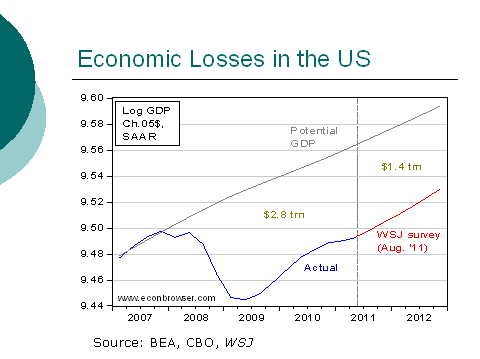
There’s no question and I don’t want there to be any doubt in anyone’s mind as to our view on this: that right now the short-term imperative is to try to get the economy going again. The losses realized have been extraordinary, and nothing we say about the longer term adjustment measures necessary should take away from the idea that the first imperative in the short run is recovery. However, in the long run, the U.S., like the other major debtor countries, confronts a real serious problem with an extraordinarily large accumulated debt, a debt overhang, if you will. And our fear along these lines is reflected in what George mentioned before, the S at the end of the title of the book. The fear that if the debt overhang and the broad implications of the debt crisis are not appropriately confronted, we face not only a lost decade, which is the decade that we’ve just been through which has been lost in terms of per capita income growth, but the prospects of another lost decade to come if we do not deal with the underlying problems of a country that has accumulated extraordinary levels of debt and does not seem at this point at least to be dealing very productively with the aftermath of the crisis.
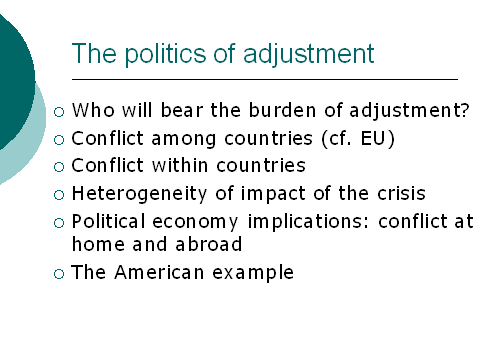
So, what is the political environment or the political economy of the adjustment process that we face? Well, one thing we know, I think, from crises past, is that the aftermath of a debt crisis always resolves into political battles over who will bear the price -- the burden of adjustment. And there are two typical dimensions of that battle. The first is across countries. Debtor countries versus creditor countries; the creditor countries, of course, wanting to recoup as much as they can of the credit that they’ve extended and debtor countries wanting to reduce as much as possible the burden of debt on them.
But, there’s also a dimension within countries where groups within particular societies, whether in the creditor societies or the debtor societies, struggle over who will be asked to bear the burden of adjustment. We see this -- both dimensions, actually, borne out in the European Union today where on the one hand the conflict appears to be creditor Northern European countries versus debtor Southern European countries, moving Ireland to the south for the sake of argument. So it seems to be -- it seems to be Germany versus Greece or Germany and the Netherlands versus Greece, Portugal, etcetera. And that’s one dimension of the conflict over who will bear this adjustment burden.
But within countries there’s also a very similar division. Within Greece, within Portugal, within Spain. Will it be taxpayers, public sector employees, workers, managers, beneficiaries of government spending? Even within Germany will it be the financial system? Will it be taxpayers who will be forced to pay to work out from under this debt burden? That’s the conflict that is taking place in Europe and it is the conflict that is beginning to and is actually is taking place I think within the U.S. today.
One of the reasons the conflict is so heated is that the impact of the crisis is often very different among different groups in the population. I remember something that I should mention, being in Brazil in 1985 in the midst of the aftermath of their debt crisis. And this was before democratization had taken hold. The then military dictator of Brazil made a famous speech on television in which he said Brazilians have to come to realize that the party is over. And the next day, on the streets of San Palo and Rio, there were mass demonstrations and the banners read, “The party is over and we weren’t even invited.”
And that’s sort of the situation that we find ourselves in in many countries today -- a feeling that there’s a massive adjustment burden being placed upon the populations of many of these societies and that the benefits of the party were not equally shared while the burden is being unequally distributed.
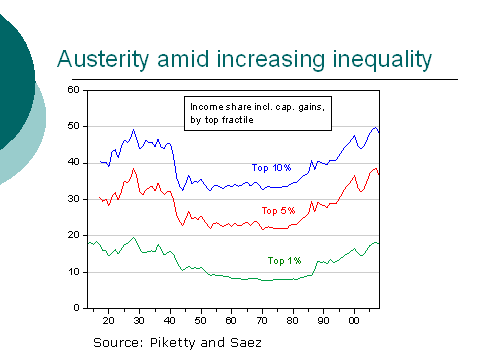
A backdrop to this, a very important backdrop, and now I’m turning to the American case, a very important backdrop is that all of what’s been going on in the last few years is that the crisis takes place against a backdrop of rising income inquality in the U.S. This is the cardinal underlying social and political reality of the U.S. since the early 1970s. That is, that income distribution measures in just about every way you might imagine, has been getting more unequal. That is true even at the height of the borrowing and consumption boom of the 2002-2007 period. It is true that the economy grew in that period, but even the benefits of that growth were very unequally distributed.
So if we look at the 2002-2007 period -- in fact, two-thirds of the income growth of the U.S. economy as a whole are realized by the top one percent of the U.S. income distribution. If you break that down, that top one percent sees its income grow by 60 percent in that 2002-2007 period; the bottom 99 percent by six percent, which is not very rapid. And of course, that six percent is completely eaten away by the crisis itself. So, even before the crisis hits, there is both a long-term backdrop of increasing inequality and a sense which I think was fairly widely held that the benefits of the boom were not being equitably or equally distributed.
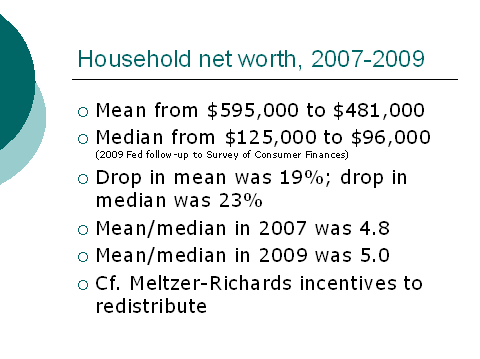
I think, I’m going to skip this because it’s a little too inside baseball as they say, to use a sports metaphor. I can come back to it if people are interested in how the mean-median ratio and the Meltzer-Richards model fits into all this but that’s maybe -- maybe Becky will want to know.
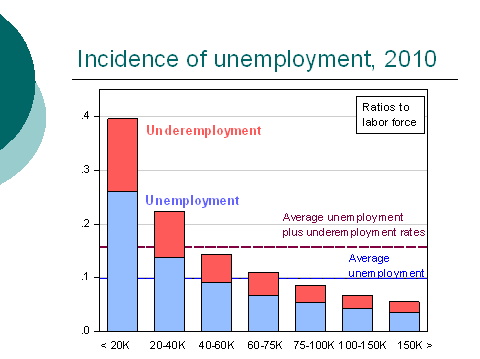
Okay. But talking about the incidence of the crisis, the broader point to make is that as the crisis hits, its effects are also extraordinarily unequal. This chart shows unemployment in blue, which is the unemployment rate. And underemployment, which takes into account involuntary part-time workers, that is workers who are working part-time but would like to work full-time, and so-called discouraged workers, that is those who have been looking for work typically for two years or more and have left the labor force.
This is broken down by income by strata of income distribution. Another way to think about it is to think of segments of the labor market. So, if we look at the bottom third of the labor force, which if you take into account the entire households involved, we’re talking about 100 million people, households approximately below $40,000 a year, at this time in the middle of 2010, when the national unemployment rate was about 9.8-9.9 percent, in that bottom third of the labor force, the unemployment rate is 18 percent. If you then add on involuntary part-time work and discouraged workers, it raises to 35 percent.
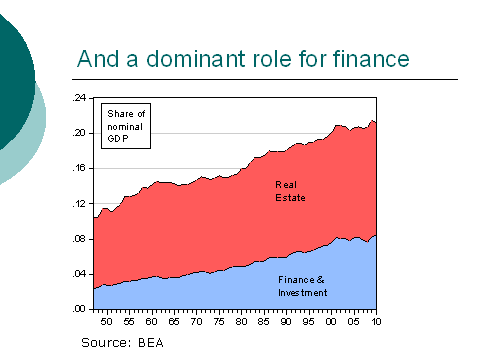
So, in the bottom third, not a few people, the bottom third of the labor force, 35 percent unemployment and underemployment. Look now at the top third households above about $85,000 a year. Same time. The unemployment rate is four percent, and the unemployment plus underemployment rate is eight percent. So, it’s easy to understand how in the aftermath of the crisis one segment of the population is really almost at depression levels of unemployment and underemployment. The other segment is doing worse than usual but really not that badly. And how there might be massive disagreements as to how aggressive the government should be. How much it should borrow? How much it should raise taxes? What it should do to confront the crisis that really is having very uneven incidence on the population as a whole?
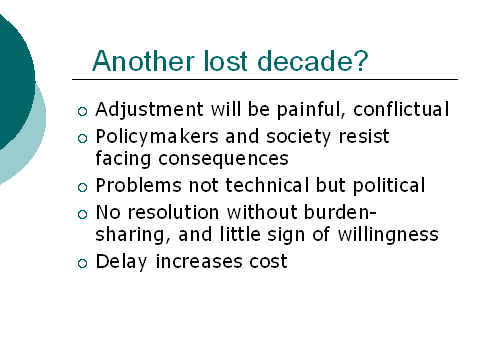
So that sets a backdrop for some of the political economy of the adjustment process, and is one of the reasons why the political debates in the U.S., as in Europe, have been as fierce and as polarized and as gridlocked as, in fact, they have. This against the backdrop -- this is for Simon’s benefit -- the backdrop of the fact that the role of finance in the economy, and we present some evidence to this effect, the role of finance and related industries in the political process has been growing quite substantially over the past 25 or 30 years.
So, the underlying implications of this I think are cause for concern. The U.S., like the European Union, faces a very difficult process of economic adjustment. That process will not be easy. It will impose substantial costs on society. It will call for sacrifices from many different portions of society. Those sacrifices can be distributed in a myriad of different ways. The political problems faced by pretty much every society, certainly by all the debtor societies, including the United States, are not primarily technical. They’re primarily political. They have to do with who will be asked to make the sacrifices necessary to bring the economy back towards some semblance of health, who will be asked to sacrifice consumption, income, wealth, whether as employees, employers, or taxpayers, or beneficiaries of government expenditures.
At this point, the overarching implication that we can draw from observing what’s happening in Europe and the United States is that no one is willing to even attempt to reach a consensus over the distribution of the adjustment burden. And if we know anything from crises past, it is that the longer you delay dealing with the crisis effectively, the worse it gets, whether that has to do with the Latin American debt crisis of the ‘80s or the Japanese crisis of the ‘90s, or our own savings and loan crisis. Delay raises the cost of resolution. We start by drawing the comparison with the lost decades of Latin America and Japan. I think it is not coincidental that both of those sets of lost decades began with debt crises and it is also not coincidental that in both instances there was an extraordinarily unfortunate and unnecessary delay in addressing the underlying causes of the crisis. And so that’s one of the many things that concern us today.
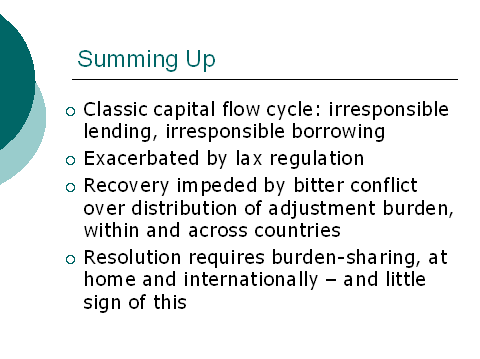
So to sum up, we see the current crisis as representing a classic capital flow cycle in which, whether from the standpoint of surplus countries or the standpoint of deficit countries, you have an extraordinary boom in lending and borrowing. And without passing judgment -- ethical, moral, or otherwise -- it seems to us that if the lenders were irresponsible, the borrowers were irresponsible, there’s plenty of irresponsibility to go around, that the capital flow cycle, the macroeconomic imbalances of the 2001-2007 period were substantially exacerbated by lax regulation in financial markets throughout the world. That today the recovery is weak is a great cause for concern, but the longer term cause for concern is that not only the recovery but a restoration of balance in both domestic and international economies is we think impeded by continuing conflict -- some might say gridlock -- in addressing the way in which societies and countries themselves will deal with the adjustment burden, both within and across countries.
I think it’s pretty clear, as the Europeans are gradually and grudgingly realizing, and Americans I think not quite so much, that resolution of these longer term problems requires the sharing of burdens, both at home and internationally. But unfortunately, despite plenty of rhetoric to this effect, we see precious little indication of any forward motion on constructive burden sharing. And so, we continue to worry that unfortunately the prediction implied by the S at the end of the title of the book may be borne out by reality.
So with that I’ll stop and turn it over.
DIANE: Thank you for inviting me to read and comment on this book. You have to kind of force me with assignments and deadlines like that these days to get me to actually read. This book was amazing though. I was so happy to read it. Menzie and I worked together at the end of the Clinton Administration on the Council of Economic Advisors and I think ever since then I became obsessed with the Bush Tax Cuts and the fiscal irresponsibility of them. So I was really happy to read the book and see that Menzie and Jeff--I assume Jeff had some role in this -- in almost every chapter got back to the Bush Tax Cuts slamming as well.
But almost in every single chapter there is something that reminds you that, yeah, the Bush Tax Cuts were still a bad deal. So I like that.
It struck me as I was reading this book and as some people around me, including one of my college daughters has been asking me what I think about the Occupy Wall Street Movement, that this book could be like the Bible for that movement because, you know, a lot of what my daughter or others are protesting on Wall Street is basically the stuff that you outlined very well and explained very well in this book. I even did not really understand much about the credit crisis and the subprime mortgage issue other than the phrase “slice and dice.” You know, I heard that over and over again but you had like a whole chapter that explained to me what that slicing and dicing was all about. And that was very fascinating.
It just strikes me that so much has happened badly for our country in the past decade has been both the private sector’s fault and the public sector. I mean, both parts of the economy have behaved badly over the past decade, and that’s because we didn’t need more of a reason -- Americans didn’t need more of a reason to borrow. And yet right at the time when our government decided to borrow massively to support tax cuts, we didn’t get what could have been maybe a private sector offset which could have been maybe that the private sector would have started saving more.
But instead, at the same time, we had foreigners very willingly lending to us, monetary policy that was very accommodative, and so interest rates are very low and house values are rising. We could consume out of our house value. It’s like we didn’t need more reasons to consume or to borrow for the wrong reasons. And so we have the government borrowing for the wrong reasons, not putting the money into longer term investments but to tax cuts that would be largely spent. We had, you know, the private sector borrowing for the wrong reasons. So, you know, they’re not borrowing as much to pay for their kids’ college educations as they were borrowing to expand their house or to take vacations.
So it strikes me that this book is a big “I told you so” book. And it’s a very compelling “I told you so.” And so it shouldn’t be just thought of as “I told you so,” it should be “I told you so and listen to me now.” So Menzie and Jeff’s last chapter -- not the very last conclusion chapter which is just a few pages long but their second to last chapter, which is something like: “what do we do now? Or what should we do now?”, is really great because it has -- it sort of wraps up what have we just told you went wrong? And how can we come out of this learning something from it? You know, we have to get something good out of this, so let’s at least learn some lessons as we go forward and maybe the S on Lost Decades doesn’t really have to come true.
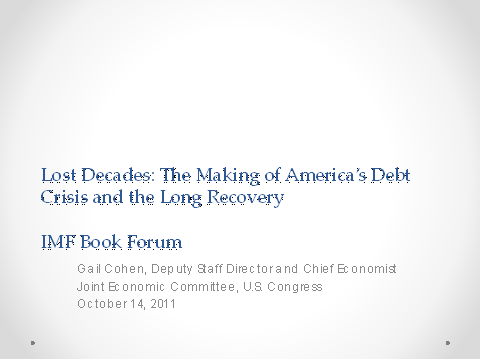
GAIL: Thank you very much. I, you know, want to second all of Diane’s comments. The book was wonderful and I really appreciate how clearly you laid out some of these issues. First of all let me say that my comments reflect myself and not any views of the committee that I work for or any members. But I also want to thank the work of the committee -- there are a lot of people, a lot of economists and policy analysts whose work I’m going to draw from in this.
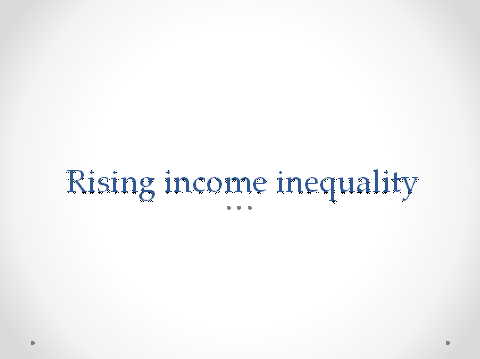
You know, it’s interesting, Jeff, that your presentation just feeds right into the issues that I’d like to address in the book, and that is about the income inequality issues that you raised.
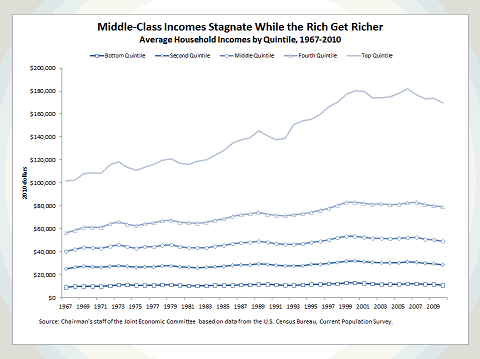
This is income by quintile. So it’s the most recent data we can get from the Census Bureau. You can see that since 1967 incomes were rising, especially for the top income quintile, whereas, middle class incomes remained stagnant over this period. You know, we’ve had a slight fall in income for the highest income quintile since the financial crisis and the recession, but you can see the rapid growth.
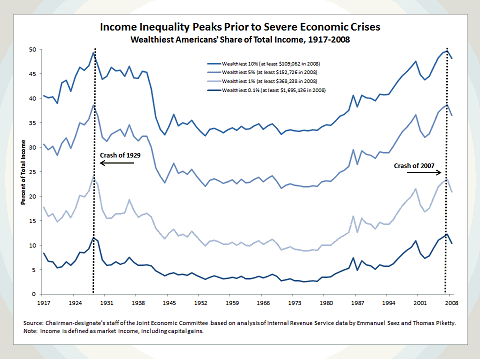
And this is very similar to the picture that Jeff put up. You know, what seems to be, when you look at this and you look at the history you can see that income inequality reached a peak, prior to this one right before the crash in 1929. And then policies were put into place and income inequality actually dropped until later on, you know, late in the 19th century or 20th century I should say. And then rose until the crash in 2007-2008. And, the question for me really is are we going to put policies into place that will lead to a decline in income inequality? Or are the policies that we’re putting into place not going, you know, going to exacerbate income inequality and will that lead to another crash?
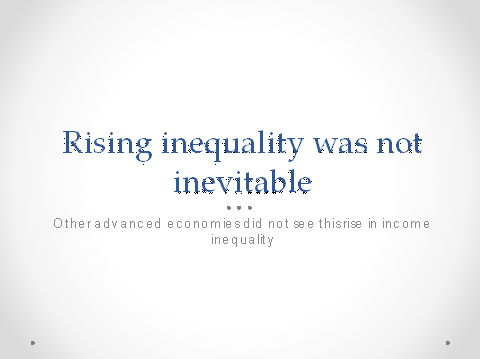
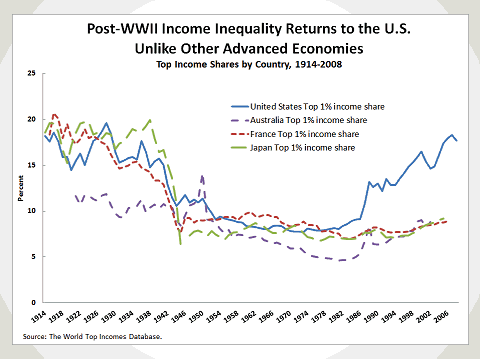
Rising inequality wasn’t inevitable. In other advanced economies they didn’t see the same rise after 1929. And so just a comparison, if you look at Australia, France, and Japan, they didn’t see that rise that we saw. And when you think about financial crises, I think part of the problem, that people were facing yes, people were, borrowing more than they should -- but with stagnant incomes and rising costs, then borrowing was necessary for the middle class. You have health care premiums -- the most recent Kauffman Family Foundation said $15,000 a year for health insurance premiums alone. So you have rising costs of health care that they’re facing. You know, that’s even for people who have health insurance. And house prices were rising. So the middle class was not seeing their income rise the way, you know, people who had more -- the richer people were seeing.

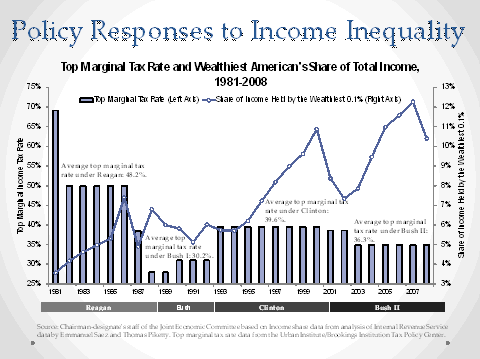
One policy response to income inequality, you know, during the Clinton Administration -- we did raise marginal tax rates. It did not completely eliminate income inequality but at least there’s this movement toward trying to alleviate income inequality that we didn’t see under the Bush Tax Cuts.
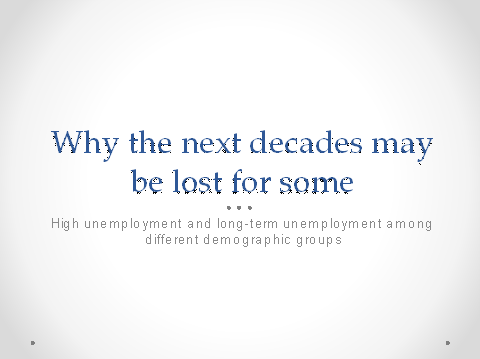
But what I’m really concerned about is whether or not this decade is going to be lost for just some people, that the future, the S on the decades that everyone has been discussing will be only for some segments of the population and that some people will do fine. And that’s what we really have to worry about.
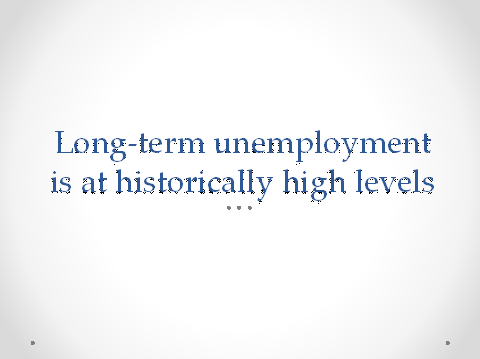
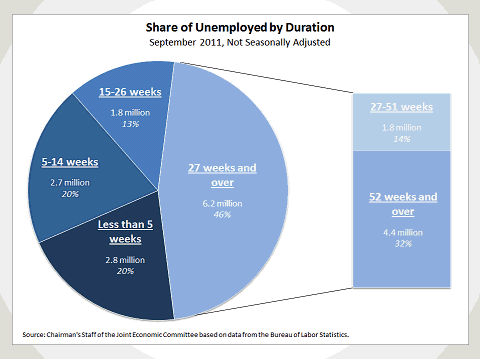
This is a period where long-term unemployment is at historically high levels. We have people who are long-term unemployed that have been unemployed for six months or longer. It’s almost half of the unemployed and it’s 32 percent of people who have been out of work for over a year.
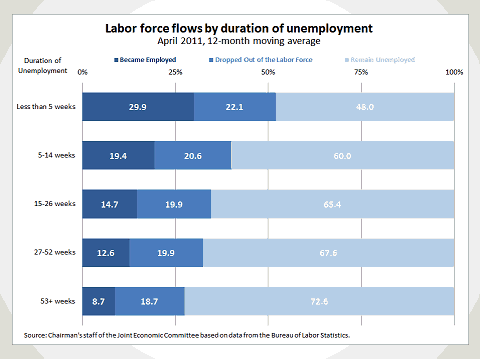
And then when you look at whether or not you can get a job, the probability of getting a job is dependent on how long you’ve been unemployed. I mean, we’ve heard these anecdotal stories that people are putting ads in the paper, you know, the unemployed need not apply. Must have a job. You know, discrimination against the unemployed. But when you just look at labor force flows, you can see that only 8.7 percent of people who are unemployed for over a year got a job in the next month, whereas, you know, for people that were unemployed for less than five weeks, it was about 30 percent that got jobs.
What’s really interesting I think is this middle bar, people that dropped out of the labor force. Generally, you would expect people who have been out of work a long period of time to become discouraged and actually drop out of the labor force, but we’re seeing historically low levels of people dropping out of the labor force. Now, in some sense I think some of the policies we’ve put into place have encouraged labor force participation; that the extension of unemployment insurance benefits, yes, they raise the unemployment rate but probably because people are staying in the labor force longer and not dropping out of the labor force. And frankly, you can’t get a job unless you’re looking for a job.
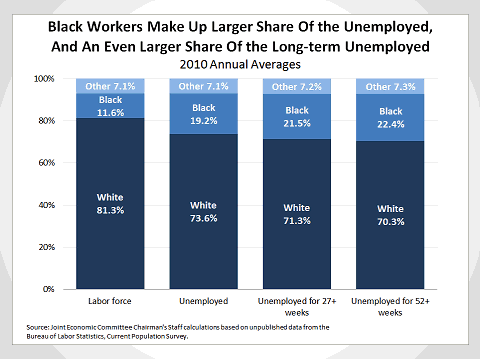
You know, certain demographic groups have been extremely hard hit. If you look at the share of the labor force, the unemployed and the long-term unemployed, you can see African-American workers are disproportionately hit by unemployment and long-term unemployment.
The bar on the left is those unemployed for 52 weeks or more.
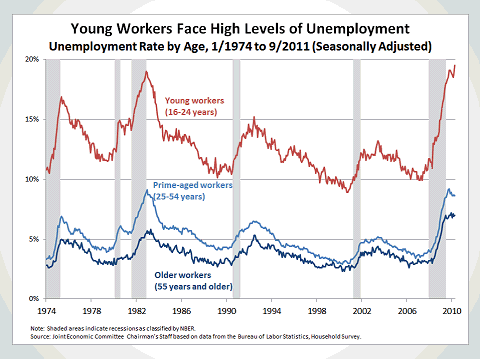
And finally, another group of workers that we are really concerned about our young -- the younger workers. The unemployment rate really high for younger workers and it’s quite scary that we have 20 percent of younger workers age 16 to 24 being out of work.
So, when I read the last chapter, those are the thoughts that I was keeping in mind. Whether or not policies that we put into place in the future, are they going to exacerbate income inequality issues? And I think a lot of the programs that you advocate are things that will help income inequality. And I think that we really need to keep our eye on this. I think education is so important. We know that growth of jobs is going to come from higher education jobs. That’s most likely where the growth is going to be, and that we’re now facing this time where state and local governments are facing heavy cuts. And so what is that going to mean then for people who don’t have enough money? They’re going to have the public education system maybe not doing as good a job as well as higher education.
So, you know, I think we need to keep in mind education. I agree about retraining workers and the trade adjustment assistance. The one thing that I am worried about, and this is again when you look at the different classes of workers, is raising the social security retirement age. I think that for a lot of workers working later in life is not view so much as a negative and they are, you know, happy to continue working later than they were before. But you have a class of workers, especially in manufacturing and construction, workers that may not be physically able to work until their 70. And so that’s something that we should be keeping in mind, and whether or not that’s going to lead, again, to problems with inequality later on. But thank you very much.
SIMON: Thank you. I’ll just stand so that people in the back can see me and vice versa.
First of all, I’d like to congratulate the organizers on this event. It’s a terrific book and a book that we all need to think about and discuss in the United States today. This is also a great location. I think it was one of Reagan’s campaign managers who established always book a venue that’s slightly too small for the audience. So standing room only for this book seems entirely appropriate.
And thirdly, it’s great timing. Diane mentioned Zuccotti Park and Occupy Wall Street. And I think, and I understand the park was not cleaned today, so they were not forced out. This is becoming a very interesting moment from the left. And in terms of the articulation of some of those grievances, it’s also a very interesting moment from the right. I would predict, not with confidence, but I would predict that the fight for the Republican nomination takes up some of the issues articulated just now, including the idea that “too big to fail” is too big. Because it’s not a market; it’s a subsidy scheme. A very inefficient, dangerous subsidy scheme that actually exists in a reinforced fashion compared to whatever you think was part of the problem in the run up to the crisis as you describe.
So these issues are very much in the air, and I hope that we’ll have a lot of back and forth about them. Let me just, by way of provoking perhaps some of that discussion, make three points. First of all, I’d like to say for the record there’s only one word I disagree with in this book. I don’t know the exact length. It’s probably about 60,000 words. So one out of 60,000 is not bad. It is a fairly big word though. It’s on the cover. It says “The making of America’s debt crisis.” I would substitute Europe. If you go back -- pull up your original slides or the last slide, the summing up slide, pull up one of your sides and look at that description of the flow of capital of the credit cycle and of the consequences, the lax regulation, bitter conflict, distribution of adjustment burden. I’ve been to Zuccotti Park recently. I haven’t been to Athens but I think it’s the same sort of issue. And as Jeff said, many -- referring to Brazil, the spirit of “the party is over and we didn’t get invited.” That’s absolutely what Europe is about today and what I think much of the discussion in Italy will be in the near future. And much of the discussion in Germany will be about who had a party at their expense or who needs to do what kind of adjustment.
So these issues are absolutely pervasive. I think though I’m a little less negative about the immediate prospects in the United States than perhaps the authors are. The book is very nuanced and full of all the detail. Just in terms of the tone today, with the reserve currency, right? As long as official -- as long as foreign central banks want to accumulate U.S. government debt, we get a break. Now, how long does that break last? I have no idea. How much of a current account surplus do the Chinese want to run or how much do the Japanese run or how much do oil producers run? I don’t know. How long does that go on? Maybe it’s three days. Maybe it’s three years. Perhaps it’s longer. But that has a big impact on whether we have time. It doesn’t mean that I’m disagreeing with you on substance. I’m suggesting we have a bit more time than we might have otherwise. We caught a break here. We did a lot of damage. Actually, much of this, as you articulate globally, was about us. But it’s not only about us. And it’s not only about housing. It’s also about the corporate sector in some places. It’s in a big way in Europe. It’s about the government sector leveraging.
So we leveraged the households, the financial sector. The government stepped in as a backstop. That hasn’t gone so well in terms of recovery and we have a big debt issue to deal with, no question about that. In Europe they leverage the government. There is no backstop. They don’t even have a central bank to call their own in many of these countries. They gave that up and now they face the consequences.
So I think this is exactly the problem from which Europe will really struggle to recover. We may get a bit more lucky, although we’ll see how our political debate goes and we’ll see whether people confront these issues. And I think the big thing that will not get addressed is the way that Gail framed it, which is, you know, for sure this is lost decades for some people. They already lost them. Right? This is a continuation of losses.
And I wouldn’t actually frame it, Gail, as inequality. I think many Americans don’t get very excited about inequality. I would frame it in absolutes. What are your job prospects? What are your children going to do? Is there going to be work in your community? That’s not inequality. I mean, it’s inequality yes. It’s a reflection of inequality perhaps but it’s about absolutes. It’s about earning less and having a lower living standard than your parents did for a lot of people but not everybody. That is, I think, the new reality. And I rather suspect whatever comes out of the political process will not deal with that.
The two other points I want to make -- these are questions for the authors and questions that I think we should all deal with -- suggest that we have more problems coming in the future than even what we laid out today. The first is about credit. You know, I think the common element across all our countries, all the countries that belong to the IMF and certainly all the industrialized countries at the center of this mess, is we’ve lost totally control over credit. We don’t even have a good concept of what is credit? How do we measure credit? How do we control credit? How much credit is too much? All right? How much financial intermediation is too much? How much leverage is too much in terms of ultimate borrows?
You know, in the original debate about the founding of the Fed after the crisis of 1907, there were two sets of people who expressed concerns about creating a central bank in the United States. The first -- on one side there was Nelson Aldrich and the very powerful people he represented. Nelson Aldrich was a senator from Rhode Island. His daughter married John D. Rockefeller’s son. You could say he represented the oligarchic side of American politics. I mean that without any -- not in a pejorative sense.
And Aldrich and his friends, who thought about this a lot and ran the National Monetary Commission, said they weren’t sure they wanted a central bank because it would encourage governments to be irresponsible and it would shift you away from the traditional ethos of the gold standard towards deficits, towards being able to finance deficits.
On the other side of the political spectrum there was Louis Brandeis and the Pujo Committee. And they say, well, we’re not sure we want a central bank because that’ll encourage the oligarchs, the Wall Street guys, to borrow excessively because now there’s a backstop. They were basically articulating the same concerns about moral hazard you can read on the editorial page of The Wall Street Journal. Right? So the right and left have converged in some interesting ways.
Now, I would suggest looking at Europe now, that the experience of Greece suggests Nelson Aldrich was right. And the experience of Ireland, laid out by Menzie, for example, moments ago, suggests that Brandeis was right. So what is the right level of credit? What is the role of the central bank when you have these credit booms and busts, even before you start to globalize them? How would you know? How do you operationalize that? We became very convinced after Volcker, after inflation was conquered, that we knew what central banks were about and we knew what they had to focus on. Everything else was incidental. I think Alan Greenspan said you can clean up afterwards.
Well, perhaps not. And I think you’re actually saying that Greenspan was wrong on that issue, but that means you have to change what central banks do and how you think about credit. And I don’t think we’re even having that discussion.
Last point, and this is the really disturbing one and I apologize for doing this on a Friday afternoon. I don’t want to spoil anyone’s weekend. This is bothering me a lot right now. How much government debt is safe to have? Now, there are some people in official circles, including some of my former colleagues here, who use 60 percent of debt to GDP ratio. Gross debt you might argue in the U.S. context we should take net debt as a safe ratio is a tough goal to achieve. I’m not sure where the Concord Coalition is. Diane can fill us in afterwards on that. Sixty percent is a lot of debt historically speaking for many economies. And depending on what kind of shocks you think you’re going to face, maybe that’s too much. This crisis -- well, the office can actually come back to you on the numbers but I like to use the CBOs. The change in medium term projection from the CBO, from the Congressional Budget Office for 2018, they did a projection right before the crisis and they’ve done projections after the crisis. And the change in the 2018 debt to GDP number is 50 percent of GDP.
So, that’s my benchmark for the kind -- the fiscal damage done when the government backstops the economy. Mostly it’s lost tax revenue, of course. It’s not much about top or other direct so-called bailout money. It’s mostly lost revenue. It’s a little bit about the stimulus but mostly not. Mostly it’s the automatic stabilizer.
So if you think you’re going to have a fiscal hit, 50 percent of GDP and you’re carrying 60 percent of GDP as your baseline, well, then you’re going to end up with kind of a high debt level and then all the distribution issues, the adjustment burden issues, and then the inequality issue and then the issue of do people want to buy your debt around the world? Maybe we don’t get so lucky next time. So 60 percent seems kind of high to me. But, what is the right number? On what basis do you make that decision, because that’s a real issue medium term for the economy? What taxes are you going to raise, and what spending are you going to cut or curtail?
Now, I hope if you have a minute after this session is over and you’ve grabbed your signed copy of the book and you want to find a place to peruse it, I suggest you walk down Pennsylvania Avenue and go past the White House and look at the Treasury Building to your right. You probably don’t want to loiter there. I think they move people on by. But if you look to your right you’ll see a statue. Now, whose statute stands on the north patio of the Treasury Building? It’s Albert Gallatin. It’s not Alexander Hamilton; that is on the other side of the building. It’s Albert Gallatin. Now, why would Gallatin, a finance minister who most of you, I think, with a few notable exceptions have never heard of, the longest serving -- the fourth and longest serving Treasury secretary in the United States -- why is his statute in front of the Treasury Building?
Well, at least in my reading of the history it’s very simple. That at the beginning of the American Republic there was a huge debate, a very big debate between Hamilton on the one side and the Jeffersonians, including Jefferson, Madison, and their Treasury secretary, Gallatin, about how much debt to have and what fiscal responsibility meant and how to run public finance in a country like the United States with our political system. And this debate was not resolved for a long time until the British showed up in the War of 1812 and trashed the place. They burned Washington. The U.S. had given away its tax base. There was no military left. You wouldn’t ramp up in any reasonable timeframe. They abolished the First Bank of the United States. There was no public debt manager. There was no ability to borrow short-term and use those resources. The Jeffersonians, Madison’s side, and Gallatin -- although I think Gallatin himself had realized this sometime before but people like Henry Clay, leader of the War Hawks in Congress, for example, came to this realization rather late -- realized that Hamilton had been right, that you needed a sturdy, robust system of public finance. It needed to be combined with a sense of fiscal responsibility. And that’s the consensus that the U.S. established in the 19th century, the Hamilton-Gallatin consensus I would suggest, that carried us for a long time and served us very well until the period on which this book focuses. Thank you.
MR. AKERLOF: Thank you. Thank you to everybody.
(Applause)
MR. AKERLOF: Menzie and Jeff, do you want to answer some questions?
MR. FRIEDEN: Sure. Okay, sure. Thank you, all three of you, or all four including George, for the very kind comments.
I wanted to -- because these are fascinating issues I wanted to just keep the conversation going. I don’t want to talk for too much and Menzie will say a few things and then I think we should open it up.
On the last point, Simon will know the quintessential expression of this Hamiltonian view, which is that Alexander Hamilton once said a national debt, if appropriately managed, can be a national blessing. So the idea here is that borrowing in and of itself is not necessarily a bad thing. Fiscal responsibility is a phrase that’s thrown around. Irresponsibility and responsibility are phrases that are thrown around a lot. I don’t think either of us and probably any of us think that borrowing in and of itself is somehow, you know, in a Shakespearian sense, a bad idea. What is a bad idea is borrowing for unproductive purposes, borrowing without making clear what the purposes are, and borrowing to cover services that people say they want but aren’t willing to pay for. And so those are some of the concerns that I think we have in this short and even the long run.
I wanted to address -- I think Menzie will address the credit issue, but I wanted to address the first two points that Simon, or the first point which has two component parts that Simon made. I agree completely. In some ways our description of this crisis fits even more completely in the European case because the European debt cycle looks a lot more like the Brazilian or Turkish or Russian or American 1890s for a number of reasons. First of all, although some of the borrowing does go to the government, in the case of Spain and Ireland, which are two of the most troubled countries, the borrowing before the crisis is entirely to the private sector and it’s financing the housing book. The government deficit, the budget deficit, are because the government has to then bail out their financial system when the banks all go bust after 2008.
But they do have the same kind of capital flow cycle where funds, trillions of dollars, flow in from Northern Europe to Southern Europe, drive up the price of housing, lead to a financial boom which becomes a bubble, a consumption boom more broadly and then bust, where it again follows the path of more traditional debt crises. Unlike the U.S., but like in other instances there is a sudden stop, that really from one day to the next these countries find it either impossible or extraordinarily expensive, prohibitively expensive to borrow. And that’s why they find themselves much more immediately forced into adjustment problems, and that’s why Greece, Portugal, and other countries are in the midst of much more difficult political circumstances than we face.
We have the great exorbitant privilege of being the reserve currency, which means that in the worst crisis since the 1930s we were the best place to be because everyplace else was even worse. And in a world in which no currency instills much confidence, the U.S. is better than the alternatives; the dollar is better than the alternatives. So the U.S. has been able to benefit by the fact that it can continue to borrow and people will continue to buy dollar de-nominated assets because the alternatives are even more unattractive.
I would make two points about this. The first is that I do not think -- although this is clearly an important point -- I do not think that it is likely to last forever. I think there is a limit to the world’s appetite for American assets and there is a limit to Americans’ appetite for continued foreign borrowing or borrowing more generally. And so that’s the first point I would make.
The second is that this is part of a global process. That is, it’s not just about the United States. It’s also about a whole phalanx of countries which had come to rely on debt finance consumption over the course of a decade, and a whole phalanx of countries that had come to rely on massive export promotion for a decade or more. And I think that even leaving aside the U.S., that pattern of international economic interaction is coming to an end, will come to an end. And the adjustments that will be necessary to deal with that change are going to be wrenching, in both surplus and deficit countries, and they will inevitably have an impact on the United States.
So I think that Simon is absolutely right, that the reserve currency role, the dollar in the safe haven role of the U.S., gives us some breathing room, but it does not give us infinite breathing room.
MR. CHINN: I now realize we should have written a longer book because these are all excellent points. And, you know, maybe we should have sent it around to more and more people to get more comments.
Let me just hit a couple of things. Our endurance ran out. That’s the frank story here.
I want to say that, you know, in terms of the fiscal policy, I guess I absorbed a lot from Diane when we were on the Council thinking about fiscal restraint. In fact, it was a couple years after serving on the Council that I was induced to sign my first petition ever to object to the 2003 tax cuts. So, I mean, the main point is I think you’re right that we really blew it in the 2000s. We had a chance to build up some savings in the public sector, and we used up our ammunition for any big recession or any big shock. Well, you know, people assumed in a way we were in the midst of the Great Moderation. Okay? And I think events have borne out that we’re not quite sure that that’s all over. So, yes, it is an “I told you so” book. And you can lie awake at night and think to yourself if only we had not given those massive tax cuts in ’01 and ’03.
In terms of the inequality, the one point I’ll mention -- I agree with the points -- it is surprising to me that we, you know, we worry about structural unemployment. A lot of people think about structural unemployment as being an issue about matching workers to positions. And yet we don’t think that that’s a big, big problem now but, you know, it’s a strange dichotomy. Those people who assert that there’s massive amounts of structural unemployment are pushing essentially no policies to make sure that in the longer term we are able to address structural unemployment. That is, in allowing there to be lots of long term unemployment, you’re almost guaranteeing that a lot of people will not have the job skills or the werewithal to take a job later on. And so it’s a strange dichotomy. The people who say that they’re most concerned about structural unemployment now are almost saying: let’s get lots of structural unemployment. Maybe they don’t realize it but I think their policies will lead to that.
In terms of credit, I think that’s right. One of the chief failings of my own is thinking about finance. We knew very little about what was going on in the financial world. We knew that there were all these journals called Financial Engineering but I could never force myself to pick one up and say, well, what is in here? And I think that’s a big mistake that we’re all paying for now. But the challenge remains we have to monitor and figure out and theoretically work out what is the optimal way to finance firms, households? What are optimal ways then if you understand it to regulate the system? And still we probably don’t know what is the optimal amount of intermediation. You know, the theorists were telling us that, you know, you could take a security and, you know, slice and dice it once, twice. You know, why not? And in fact, that was a CDO2. Why not CDO3? In principle, there was no reason why not to. Now we have a better idea but I’m not sure we know completely exactly when and where you should stop. We have an inkling that maybe we went too far but that’s not theoretically backed up. That’s sort of backed up by it didn’t work out last time.
The last thing is about debt. And I think those points were well taken about, you know, what’s the right level of debt? Actually, I don’t know. In most theories you don’t have tied down an optimal level of government debt. But I will make one observation about this idea of contingent liabilities. I think they’re really important. They’re really everywhere. And so in the financial statement of the United States, actually, they tally up a bunch of contingent liabilities. You know, pensions, so forth, insurance on crops and going on forward. But actually, some of the biggest contingent liabilities are exactly the ones that Simon talked about. It’s like when the economy goes into a tailspin you’re going to have to pick up all the tab for the banking system. Maybe it’ll turn out that the actual accounting value of the cost isn’t too big but there have been these other associated costs where you have to do stimulus and so forth. And those are all lurking out there.
And some people believe that you can “just say no”, to take a phrase from the ‘80s. I’ll show my age. If you just say no to bailing out or taking actions in the future, then, you know, you can just look at the official debt to GDP ratios. But I think what we’ve learned is that there are, you know, when something, a big, bad shock hits, the government can’t say no. And the best thing then is to make sure that you can keep a lookout and regulate out some of those big, big liabilities if you can see them. I mean, that’s a big challenge. The question is whether you could do it. But I think that’s one thing that I take from this. You can’t just say that when a big shock comes along we’re just going to say no to bailing out institution X because it’s not going to be credible to say that.
BRUCE BARTLETT: One of the problems -- it seems to me that part of what you’re saying in your book is that we’ve become a small, open economy. That is, we have the monetary problems of a country like Canada we used to be able to ignore. You know, they’ve always had to look at problems of exchange rates differently than we did. And so we kind of ignored a big sector of the world economy. And now it’s come home to roost.
And that leads me to a question of what precisely could we have done differently given the circumstances? I mean, I think it’s a little bit simplistic to just say, well, we shouldn’t have had the Bush Tax Cuts. We should have had better regulation and things of that sort. And that’s all true. But that’s kind of a bottom-up kind of way to look at it. If you look at it more from a top-down perspective, we had this situation where we had a huge increase in world saving that had to go somewhere. And it’s a little bit analogous to a situation -- to, you know, in the 19th century when we were on a gold standard and suddenly we had a gold strike. I mean, what were you supposed to do under those circumstances? Because even if we had kept the budget balanced the money would have flowed into something else. As Jeff pointed out, countries that had better public finances than we did suffered just as badly in terms of their economies.
So it seems to me it comes back to two problems. The basic problem is how do you identify a boom when it’s happening? Well, I guess I wonder, absent capital controls, what could we have done to keep the money out is really, I guess, my bottom-line question.
SPEAKER: Question about the IMF’s role in this. Kind of looking ahead to next month’s G-20 meeting, what can we expect out of the MAP process? And then kind of more broadly speaking, how much maneuvering room does the IMF have to facilitate some type of scheme for adjustment across especially advanced economies that are reserve currencies that won’t be borrowing from the IMF? So how much skin in the game can the IMF really get?
STEVE PHILLIPS: Thanks. I wonder just looking at your first two points of the summing up if there is maybe a slightly different interpretation or maybe this is what’s in the book. I’ve only read parts of the pages of the book, the ones that you can see on Amazon for free. Now I have a chance.
(Laughter)
SPEAKER: This builds on the gentleman’s question. A classic capital flow cycle: couldn’t you call it a classic credit cycle or classic credit boom? Because to bring in the capital flow, I mean, you’re emphasizing the international. It seems to me that the second point “exacerbated by lax regulation” -- exacerbated seems to me a little too weak. It seems to me you just couldn’t have had the crisis, you couldn’t have had the bubble without lax regulation. But you could have had a bubble and you could have had the crisis without international capital flows. From the Amazon pages I’ve read I know you use other language about how the fuel from abroad fueled the fire, etcetera, and that’s the way I would kind of spin it is the prerequisite was the lax regulation and the ability of not only capital from within the country but from outside, you know, the outside fed it.
It may seem like just a matter of subtle wording but I think it’s a little more than that because if you really emphasize the capital flow, the international capital flow first over the credit boom and the lax regulation, then maybe the policy implication is what the first questioner asked. Maybe the answer, the first answer is taxes on capital flows, there just should be a 10 percent or 15 percent on every international capital flow to kind of choke things off there.
VLADIMIR KLYUEV: Can I ask a question? All right. Thanks.
I have two questions for Jeff. I think there was an interesting dichotomy in the presentation, maybe reflecting comparative advantages of the authors. When you look into the past for the reason why we got into trouble it’s mostly economic. And when you look into the future, of how do we adjust, there was a lot of political analysis. So I was wondering whether in the book or maybe you would speculate on the spot, are there political or institutional factors that explain why the U.S., U.K. was different from Germany and Canada, other countries that didn’t get into so much trouble?
And looking forward, I think if you think in terms of the classical model of adjustments the prediction would be (a) adjustment is delayed and we’re still witnessing that; and (b) if I remember correctly, adjustment eventually happens when one group concedes, when the cost of staying in the fight is greater than the cost of just conceding. So do you expect something like that? And if yes, who do you think is going to concede? The rich or the poor or another category? Or do you see, like, what force would push you toward a cooperative solution, sort of splitting the pain as you suggest would be optimal? Thank you.
SPEAKER: You make a very strong argument in the book that Social Security and Medicare are going to have to be reduced in order to have a long-term benefit to the country. But there is such a strong constituency for that. Do you have any optimism that that’s going to happen adequately?
LIAQUAT AHAMED: I just wanted to focus on short-run measures for the recovery. You emphasize the political division and essentially the sort of intense debate about who is going to bear the burden. To what extent is the debate about fiscal policy in the short run a disagreement about how the economy actually works?
MR. FRIEDEN: Okay. I’m not sure we’ll be able collectively to weave answers to all these disparate questions, all of which are very, very good. But let me start with a theme that ran throughout a couple of them, which is the role of capital inflows in a small open economy in the run up to the crisis and also the implications.
So, the way I would think about this, I do think that, you know, it’s always dangerous to try to identify a single cause. And I don’t think -- we do not have a monocausal argument. But that there is a very strong sense in which the capital inflows are the driver of the experience as it takes place. And a driver in a number of ways. The driver, first in the sense that it has these powerful effects on relative prices, like prices of non-tradables. That is, it’s not coincidental that the major deficit borrowing countries all realize a very substantial increase in non-tradable prices and housing prices in particular. That’s a classic result of capital inflows. It’s not coincidental and here we get to the political economy that Vladimir was asking about. So you have the U.S. is borrowing between half a trillion and a trillion dollars a year over this period from 2001-2007, about five trillion total. I think I would say putting it somewhat simply that it’s hard to imagine how you could bring in $5 trillion into the American financial system without reducing the average quality of the asset base. Of course, you know, the financial system is going to lend out to new borrowers and to riskier borrowers.
But that interacts then with the fact that the financial system is under tremendous pressure to loan out these funds and also puts tremendous pressure on the regulators to allow them to loan out these funds to ever-riskier borrowers. It’s not coincidental that as these funds start flowing in, as the banks and other financial institutions have these funds available to loan out, they are insistently pressuring the SEC and the other federal regulators to allow them to lend them out at ever higher leverage ratios in ever more imaginative ways.
So, you know, thinking about the way in which this is managed I think is crucially important. And another comparison would be we run nowhere near as big but a substantial current account deficit, ‘96 to ‘99. Right? But there’s a big difference. In that period the government is in surplus, of course. The household sector is in a small deficit. And virtually the entirety of the borrowing is going to the non-financial corporate sector. It’s the high-tech boom. All right? So that’s what we would think of as being borrowing for productive purposes.
Now, not all of it ended up being productive, but borrowing for essentially productive purposes. And this goes back to maybe the IMF idea. You know, what are the kinds of recommendations you give? Don’t borrow if you’re going to be using the funds for non-productive purposes. And after 2000-2001, the corporate non-financial sector is in surplus and households and government in deficit. And so I think it’s the composition of the uses to which the funds are put, which is a function both of the regulatory environment, the kind of the macroeconomic environment, that I think is the nexus here -- the connection that I would draw.
And then just to address Vladimir’s point, I think you would see in the book that there’s an attempt to integrate both this capital inflow story and the politics of that capital flow -- of the effects of that, whether in the regulatory environment, pressure on fiscal policy -- that is to reduce taxes, pressure on monetary policy, all of which interact to exacerbate the effects of the boom.
I’ll turn it over to Menzie. I just wanted to say quickly to Liaquat that, well, I’m not optimistic about Social Security and Medicare. But I think there is some hope for optimism in the sense that other generations will eventually get in on the game. And on the short-term issue, I think that, you know, this is one of these instances in which I disagree with one of those quotes from Keynes about how policymakers are always implementing the ideas of dead economists. I think policymakers are not implementing the ideas of dead economists. I think they’re about interests. And I think the real conflicts here are not ideological and they’re not really theoretical. They’re not John Cochrane versus, you know, whoever. They’re really about who is going to pay the price. And you have a group in the population saying we see no reason why the government should accumulate larger and larger deficits which we will eventually have to service, being the taxpayers, in order to address a crisis which is not really hitting us that hard. Back to you.
MR. CHINN: Hard act to follow. I mean, one point regarding Bruce Bartlett’s assertion that we’re, you know, talking about things as if we were in a small open economy. Well, you know, one of those research programs we had throughout the 2002s was financial globalization. So the U.S. economy is a pretty closed economy but it was, you know, if you look at cross border holdings, I mean, it was an incredible increase over the 2000s and even before. So maybe the stories that we didn’t used to tell about America became more appropriate.
Now, the more difficult question about what we could have done, you know, sometimes you hope against all hope. It would have been, you know, it would have been too much to ask for the Fed to step in and regulate more tightly the mortgage business throughout the 2000s. Okay, it might not have been the case that would have tipped the balance. You know, we had all these other massive forces but then maybe I’m more modest in saying, well, maybe we could have mitigated the extent of damage that was done to the U.S. So it’s not an either-or proposition.
And there’s also, you know, issues about how all these things interacted. They talk about capital flowing to the U.S. This gets to Steve’s point. You know, why did it come to the U.S.? One assertion was deeply liquid markets. Well, why was the market deeply liquid? Well, the U.S. bond market was mighty deep and mighty liquid because you had mighty big amounts of new debt coming out from the U.S. government. So I’m, you know, we can’t run the counterfactual and assess what would have been able to stop the episode but we can think of things that might have been able to mitigate the extent and might have made dealing with it easier. So hopefully that’s kind of an answer.
The distinction between a capital flow cycle and a credit cycle, I agree it’s difficult to distinguish. I mean, one stylized fact that’s of interest is in the run up to the crisis the U.S. was running a deficit relative to everybody in the world. You get almost any category of countries you can think of, we are running a deficit against them. Correlation is not causality. I would say that, you know, part of it is there is capital that is easily accessible. We could access it in part because of our reserve currency status. And that’s part of it, but part of it also, and this is interpreting things as building up to something greater than the sum of the parts, we essentially disarmed ourselves in terms of regulation. We said have OTS regulate the banks? Don’t worry about it. You know, all sorts of things like that combined to give an inducement for capital flow to the U.S. So I think it’s both parts. It’s hard for me to think about a boom that doesn’t have some component of savings coming in from the rest of the world. But it’s conceivable that there have been examples. But on top of it we allowed the banks to leverage up. So you could argue maybe we could have done something by just saying increase the leverage ratios and you get a boom going on.
MR. FRIEDEN: Something that Menzie said just prompted me. I think even if let’s posit for the moment that some aspect of the cycle, you know, with up and down, is inevitable at some level. I think that one of the dominant characteristics of this particular crisis was the panic that ensued in September and October of 2008. I mean, and Gary Gorton and others have identified this I think very accurately as the modern equivalent of a run on the banks, although in this instance since people save in markets and not in banks it’s a run on the markets. And that panic component I think was very closely related to a series of very explicit regulatory decisions made in 2003 and 2004 about structured finance, about the extent to which financial institutions would be allowed to not incorporate off book operations through their conduits and others into the regulatory structure. Those were explicit decisions and again, we can’t run the counterfactual but I think, I believe, that the panic component of the crisis, which is not insignificant because it is associated with some of the most severe effects of the crisis on the financial system and on expectations, were very closely related to these regulatory decisions made in the run up in 2003 and 2004 that really exacerbated the broader impact of the capital flow cycle.
MR. AKERLOF: I think we want everybody to have a chance to buy the book. So thank you very much. Thank you, Menzie, Jeff, Diane, Gail and Simon and all, for coming.
(Applause)
* * * * *
IMF EXTERNAL RELATIONS DEPARTMENT
| Public Affairs | Media Relations | |||
|---|---|---|---|---|
| E-mail: | publicaffairs@imf.org | E-mail: | media@imf.org | |
| Fax: | 202-623-6220 | Phone: | 202-623-7100 | |


